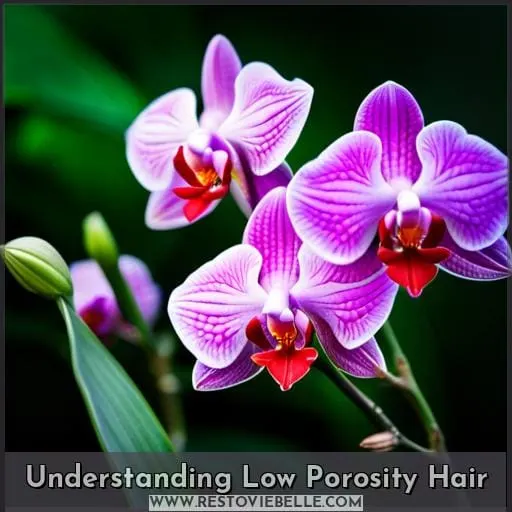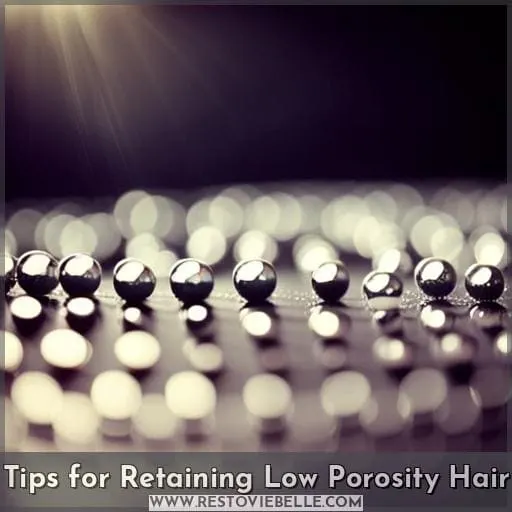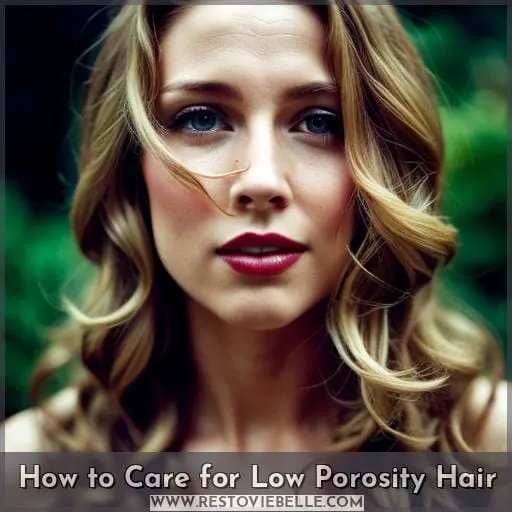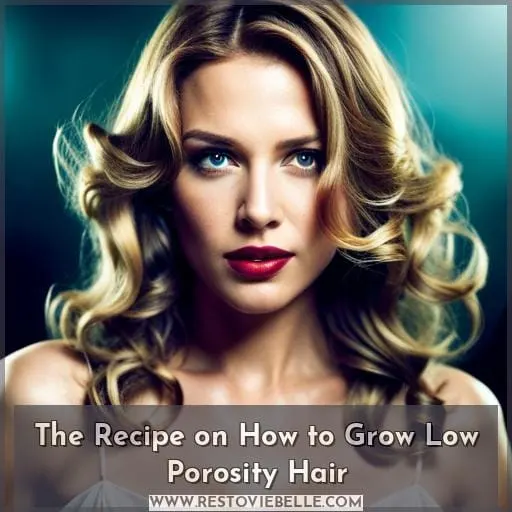This site is supported by our readers. We may earn a commission, at no cost to you, if you purchase through links.
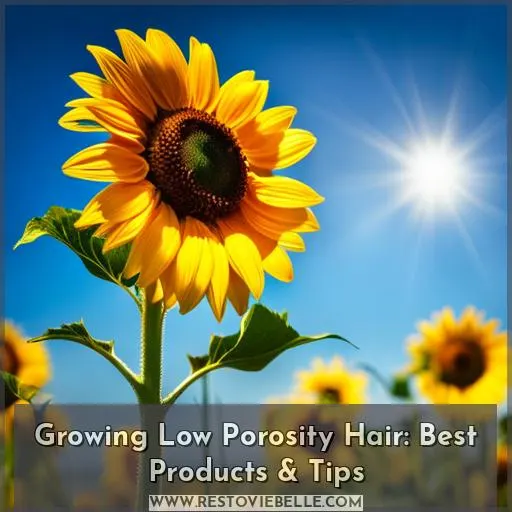 Imagine finally finding the secret to growing your low porosity hair and unlocking its full potential. You’ve tried countless products, but nothing seems to work. Well, get ready for a game-changer.
Imagine finally finding the secret to growing your low porosity hair and unlocking its full potential. You’ve tried countless products, but nothing seems to work. Well, get ready for a game-changer.
In this article, we’ll reveal the best products and tips specifically tailored for low porosity hair growth. From specialized shampoos to leave-in conditioners that will transform your locks, you’ll discover everything you need to know about achieving beautiful and healthy hair with ease.
Table Of Contents
- Key Takeaways
- 7 Best Products for Growing Low Porosity Hair
- Understanding Low Porosity Hair
- Tips for Retaining Low Porosity Hair
- How to Care for Low Porosity Hair
- The Recipe on How to Grow Low Porosity Hair
- Frequently Asked Questions (FAQs)
- Can I use heat styling tools on low porosity hair?
- Are there any specific hairstyles or protective styles that are recommended for low porosity hair?
- What are some common mistakes to avoid when caring for low porosity hair?
- Is it necessary to trim low porosity hair regularly, and if so, how often?
- How long does it typically take to see results in hair growth when following a routine for low porosity hair?
- Conclusion
Key Takeaways
- Prioritize hair hydration
- Use water-based stylers
- Find the right protein balance
- Implement clarifying techniques regularly
7 Best Products for Growing Low Porosity Hair
If you’re looking for the best products to help grow your low porosity hair, look no further.
The Redken All Soft Argan Oil Shampoo is a popular choice for its ability to soften and restore damaged hair.
For cleansing and moisturizing curly hair, the Camille Rose Ginger Cleansing Rinse is highly recommended.
If hydration is your priority, try the Aussie Miracle Moist Conditioner or tgin Miracle RepaiRx Leave In Conditioner.
And if you’re in need of repair treatments, consider Olaplex Hair Repair Treatment for damaged locks.
To achieve salon-worthy results at home, check out the Red Tourmaline Hooded Hair Dryer or Conair Retractable Cord Hair Dryer with their advanced features and convenience.
1. Redken All Soft Argan Oil Shampoo
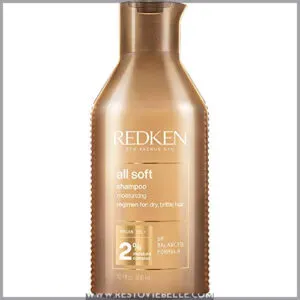
If you’re looking for a shampoo that will soften, nourish, and condition your low porosity hair, the Redken All Soft Argan Oil Shampoo is an excellent choice.
This professional salon shampoo is specifically formulated for dry hair and contains argan oil to provide deep hydration and moisture.
The Redken All Soft Argan Oil Shampoo is suitable for color-treated hair as well as fine to medium hair types. Users rave about its performance in improving overall hair health, softness, manageability, and scent.
- Provides deep hydration and moisture
- Restores damaged strands
- Suitable for color-treated hair
- Considered somewhat expensive
- Some users may prefer different scents or formulas
2. Camille Rose Ginger Cleansing Rinse
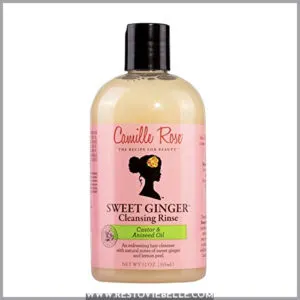
You’ll love the Camille Rose Ginger Cleansing Rinse for its ability to clarify and moisturize your scalp and hair without stripping away moisture. This hair cleanser is specifically designed for curly hair, making it an excellent choice if you have low porosity curls.
The formula contains Aniseed Oil, which not only provides relief for a dry scalp but also promotes healthy hair growth. With natural notes of fresh sweet ginger and invigorating lemon peel, this cleansing rinse leaves your hair clean, soft, and smelling great.
- Effectively clarifies the scalp and removes build-up
- Moisturizes the hair without stripping away moisture
- Promotes healthy curl formation
- Contains ingredients that relieve a dry scalp and stimulate growth
- Some customers have experienced issues with leaking caps or difficulty dispensing gel from the bottle
3. Aussie Miracle Moist Conditione
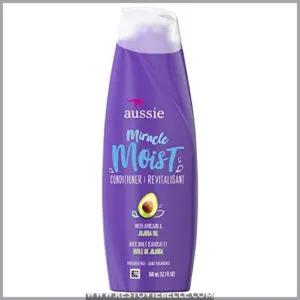
You’ll love the Aussie Miracle Moist Conditioner for its ability to soften and hydrate dry hair, leaving it feeling smooth and moisturized. Infused with avocado and jojoba seed oil, this conditioner provides much-needed moisture to low porosity hair.
It has a luscious citrus scent that leaves your hair smelling fresh all day long. The Aussie Miracle Moist Conditioner is also free of parabens, making it a healthier choice for your hair care routine.
- Softens and hydrates dry hair
- Leaves the hair feeling smooth
- Provides essential moisture to low porosity strands
- Some users may find the scent too strong or overpowering
4. Tgin Miracle RepaiRx Leave in Conditione
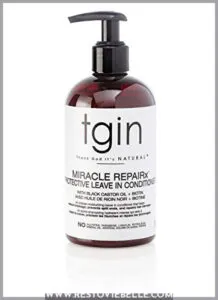
To effectively nourish and repair low porosity hair, tgin Miracle RepaiRx Leave in Conditioner is a must-have product. This lightweight cream formula contains Black Castor Oil and Biotin to reduce split ends and promote overall hair growth.
It protects and repairs damaged hair while providing deep conditioning benefits without any build-up. Suitable for color-treated hair, this leave-in conditioner leaves your locks feeling soft, shiny, and rejuvenated.
The 96% women-owned and 100% Black-owned brand delivers quality results that many users appreciate.
- Restores softness and shine to the hair
- Reduces split ends with the help of Black Castor Oil
- Promotes healthy growth with added Biotin
- Some users prefer different packaging due to its thickness
5. Olaplex Hair Repair Treatment
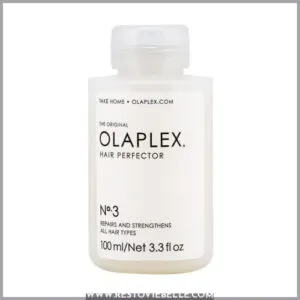
To repair and restore severely damaged low porosity hair, one of the best products to consider is the Olaplex Hair Repair Treatment. This treatment is specifically designed to address compromised hair by strengthening and protecting its structure, while restoring a healthy appearance and texture.
It should be applied generously from roots to ends on unwashed, towel-dried hair for at least 10 minutes before rinsing, shampooing, and conditioning. The Olaplex Hair Repair Treatment has received positive reviews for its effectiveness in revitalizing damaged hair.
- Repairs severely damaged low porosity hair
- Strengthens and protects the structure of the hair
- Restores a healthy appearance and texture
- May not eliminate the need for additional serums or treatments
- Initial color change may lead to dryness
- Coconut oil treatment may be recommended as an addition
6. Red Tourmaline Hooded Hair Drye
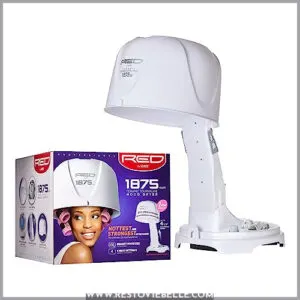
The Red Tourmaline Hooded Hair Dryer is a professional-quality tool that will help you achieve salon-worthy results at home.
This hooded hair dryer features a large, adjustable hood for even heat distribution and quicker drying.
With its powerful motor and four heat settings, you can customize your drying experience to suit your needs.
The lightweight and compact design make it easy to store and transport, while the adjustable height adds convenience and comfort during use.
Suitable for various hair types, this hooded hair dryer reduces frizz and static for smooth, shiny locks.
- Even heat distribution for faster drying
- Adjustable height for maximum comfort
- Lightweight design makes it portable
- Reduces frizz and static
- Not height adjustable as advertised or claimed by some users
- Some difficulty setting up reported by certain users
Overall though,
it’s considered a great alternative to more expensive stand dryers
7. Conair Retractable Cord Hair Drye
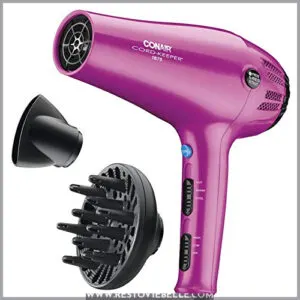
You’ll love the convenience and performance of the Conair Retractable Cord Hair Dryer for growing your low porosity hair. This hair dryer features a retractable cord, making it easy to store and travel with.
With 1875 watts of power, it delivers fast drying while minimizing damage with its Tourmaline Ceramic Technology.
It offers three heat settings, two speed settings, and a cool shot button to lock in your style. Plus, it comes with a diffuser and concentrator attachments for versatile styling options.
- Convenient retractable cord for easy storage.
- Ionic technology controls frizz.
- Fast drying with Tourmaline Ceramic Technology.
- Multiple heat and speed settings for customization.
- Comes with diffuser attachment.
- Some users found the cord retract button hard to push. -Dryer can be noisy according to some customers -Some users felt that airflow wasn’t as powerful as expected
Understanding Low Porosity Hair
To understand low porosity hair, you’ll need to know its characteristics and how it differs from other types of hair.
Here are some key points to help you understand low porosity hair:
- Low porosity hair has tightly packed, flat cuticles on the hair shaft.
- It struggles to absorb moisture, leading to dryness and frizz.
- Product build-up is a common issue with low porosity hair.
- Heat treatments can help open the cuticles for better product absorption.
Understanding these characteristics will guide your approach in caring for your low porosity locks. By focusing on moisture retention, choosing suitable products, utilizing heat treatment techniques when necessary, and practicing clarifying techniques regularly,you can effectively care for yourlowporocityhairand promote healthy growth.
Tips for Retaining Low Porosity Hair
To retain your low porosity hair and keep it healthy, continue implementing proper care practices.
- Prioritize Hair Hydration: Ensure that your hair is well-hydrated by incorporating deep conditioning treatments into your regular hair care routine. Deep conditioning helps to moisturize and nourish the strands, preventing dryness.
- Use Water-Based Stylers: Opt for water-based stylers instead of heavy creams or butters. Water-based products are lightweight and easily absorbed by low porosity hair, promoting better moisture retention.
- Find the Right Protein Balance: Low porosity hair can benefit from protein treatments to improve elasticity and strengthen the strands. However, be cautious not to overdo it as excessive protein can make your hair stiff and fragile.
By following these tips for retaining low porosity hair, you can keep your hair healthy and looking its best.
How to Care for Low Porosity Hair
Now that you have learned some valuable tips for retaining low porosity hair, it’s time to delve into how to care for your unique hair type. Caring for low porosity hair requires specific techniques and products that cater to its hydration needs.
- Focus on Hair Hydration: Low porosity hair craves moisture, so make sure to use hydrating shampoos and conditioners specifically designed for this hair type.
- Be Mindful of Product Selection: Choose lightweight, water-based products that won’t weigh down your strands or lead to product build-up.
- Maintain Protein Balance: While protein is important for maintaining healthy locks, too much can make low porosity hair stiff and fragile. Use protein treatments sparingly and monitor their impact on your strands.
- Incorporate Heat Treatments Wisely: Utilize heat treatments like warm water or steam sessions before applying deep conditioners or leave-in moisturizers. This helps open the cuticles of low porosity hair, allowing better absorption.
By following these guidelines in caring for your low porosity hair, you can help keep it healthy and strong.
The Recipe on How to Grow Low Porosity Hair
Continue your journey to grow low porosity hair by incorporating these essential tips and techniques into your hair care routine.
-
Prioritize Hair Hydration:
- Low porosity hair requires extra moisture retention to prevent dryness and breakage.
- Use hydrating shampoos, conditioners, and leave-in treatments specifically formulated for low porosity hair.
-
Maintain Protein Balance:
- While protein is important for healthy hair growth, too much can make low porosity hair stiff and fragile.
- Use protein-rich products sparingly or consider diluting them with water.
-
Deep Conditioning Regularly:
- Deep conditioning treatments help nourish and moisturize low porosity strands from within the cuticle layers where they need it most.
- Look for deep conditioners with ingredients like shea butter, coconut oil, or aloe vera.
-
Limit Heat Styling:
- Excessive heat styling can cause damage to already delicate low porosity hair.
Frequently Asked Questions (FAQs)
Can I use heat styling tools on low porosity hair?
Yes, you can use heat styling tools on low porosity hair. However, it’s important to use them sparingly and at lower temperatures to prevent damage.
Always apply a heat protectant before styling and consider using ambient heat methods for better product absorption.
Are there any specific hairstyles or protective styles that are recommended for low porosity hair?
To protect low porosity hair and promote healthy growth, consider hairstyles that minimize manipulation and friction, such as:
- Braids
- Twists
- Buns
- Protective styles like wigs or weaves.
These styles help retain moisture while reducing breakage and damage.
What are some common mistakes to avoid when caring for low porosity hair?
To care for low porosity hair, avoid heavy products that can cause build-up.
Use lightweight oils to penetrate the cuticles and open them with heat or steam treatments.
Be cautious with protein treatments as they can make your hair stiff and fragile.
Is it necessary to trim low porosity hair regularly, and if so, how often?
Regular trims are beneficial for low porosity hair to prevent split ends and maintain overall hair health.
Aim for a trim every 8-12 weeks, but listen to your hair’s needs.
Consult with a professional stylist for personalized advice based on your specific hair condition.
How long does it typically take to see results in hair growth when following a routine for low porosity hair?
Typically, it takes about 3 to 6 months to see noticeable results in hair growth when following a routine for low porosity hair. Consistency and patience are key as you nourish your strands from the inside out.
Conclusion
To achieve the full potential of your low porosity hair, it’s essential to use the right products and follow effective tips.
With the best products for growing low porosity hair, such as Redken All Soft Argan Oil Shampoo and Tgin Miracle RepaiRx Leave-in Conditioner, you can nourish and strengthen your locks.
Understanding low porosity hair and implementing proper care techniques will also help you retain and grow your hair.
So, embrace these tips and products, and watch your low porosity hair flourish like never before.
